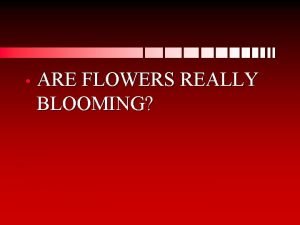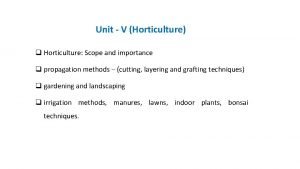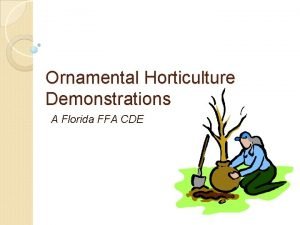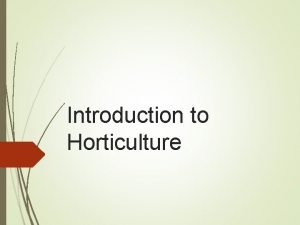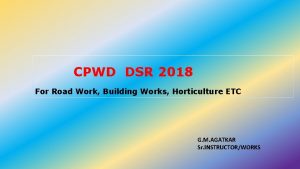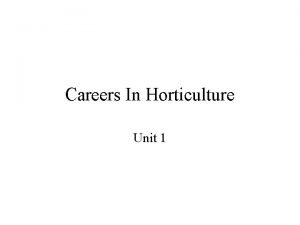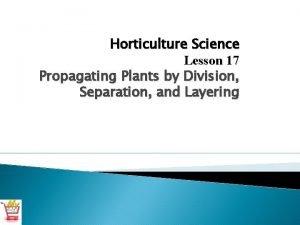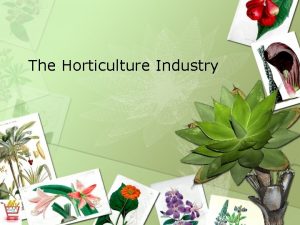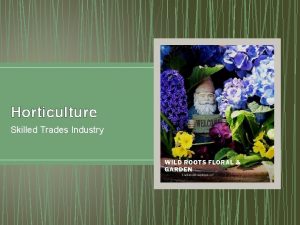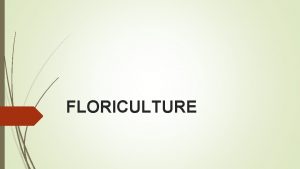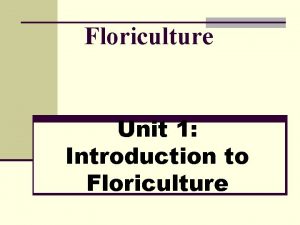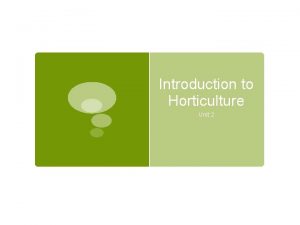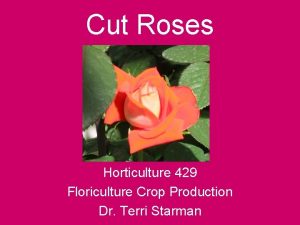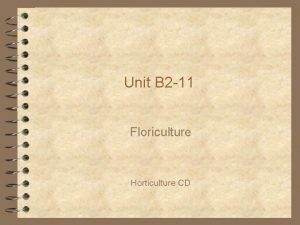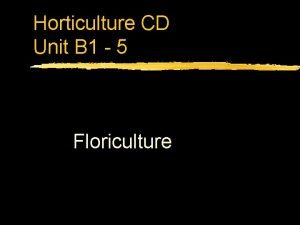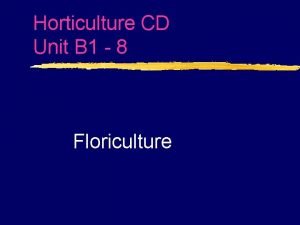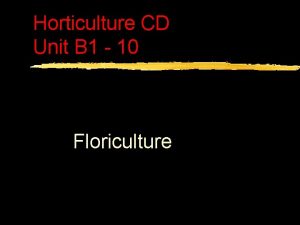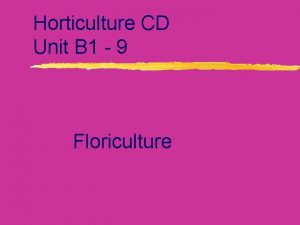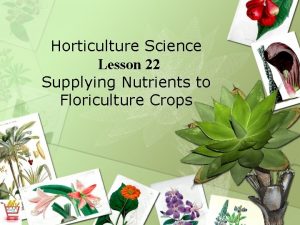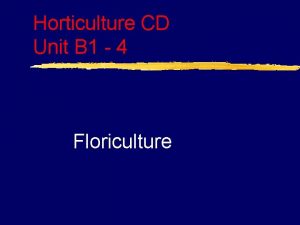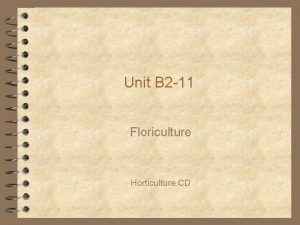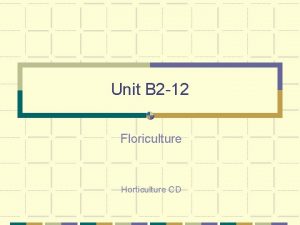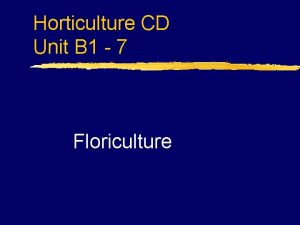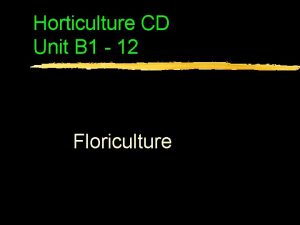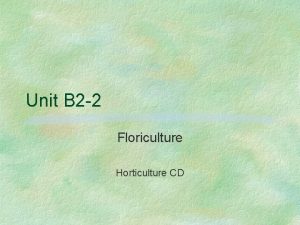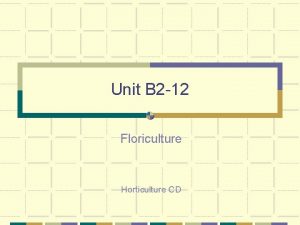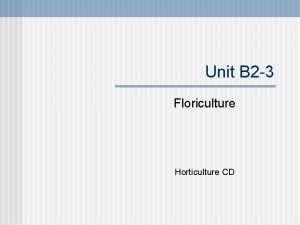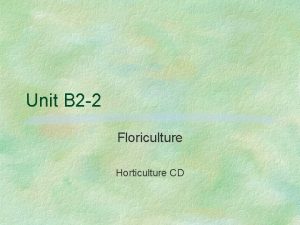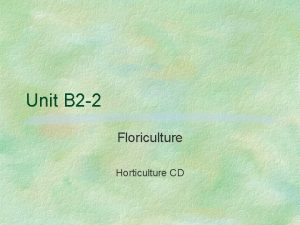Introduction to Floriculture Advanced Plant Sciences Horticulture and



























- Slides: 27

Introduction to Floriculture Advanced Plant Sciences: Horticulture and Forestry Sutherlin High School AST W. Crawford

Floriculture • What does floriculture include? – Floral design – Flower and plant care and identification – Proper use of chemicals and tools – Selling and marketing floral products

Floriculture • For this unit we will: – Learn principles of design – Identify floral plants, pests, and tools – Prepare floral centerpieces, boutonnieres, and corsages – Unit Evaluation: written test OR participate in district floriculture CDE

The Flower Industry • Most flowers imported from other countries – 90% of carnations – 89% of chrysanthemums – 71% of roses Growth of Sales in the Cut Flower Market

The Flower Industry • Most are grown in the Netherlands – In hydroponic greenhouses – 20 years ahead of most countries in production systems • Other countries – Colombia – Latin America Percentage of World Cut Flower Exports by Country

The Flower Industry • How do they get to you? – Colombian carnations, Hawaiian tropical flowers, Israeli roses, and other cut flowers are air shipped to Holland flower auctions by exporters – Inspected by and sold to buyers from around the world, who ship them to their home countries – Arrive to wholesalers who distribute to retailers/etc

The Flower Industry • http: //video. pbs. org/video/1283843915

The Flower Industry • Oregon’s Role – Oregon produces mostly horticulture and nursery plants, not cut flowers for arrangement products – But almost all Easter Lilies in US are produced on southern Oregon coast

Floral Design: the Basics • Floral design – (aka arranging); the art of organizing the design elements inherent in plant materials and accessories according to principles of design art

Floral Design: the Basics • Principles of design – rules and guidelines used by the floral designer to create a beautiful composition

Principles of Design • Proportion is the pleasing relationship between size and shape among objects and parts of objects • How do you achieve proportion? – The design should be 1 ½ times the size of the container’s greatest dimension (height/width) • Some exceptions – Container is the primary factor • • Dimensions Color Texture/material Shape

Principles of Design • How do you achieve proportion? – Solid, dark colored containers can support taller arrangements – Clear glass is better for shorter arrangements

Principles of Design • Balance in a flower arrangement refers to the arrangement’s equilibrium and equality in weight, both physical and visual • How do you achieve balance? – Physical balance: actual stability of plants in arrangement – Visual balance: perception of the arrangement being balanced–being equal in weight on both sides of the central axis

Principles of Design • How do you achieve balance? – Visual balance should be evident from three views: • side to side • top to bottom • front to back

Principles of Design • Rhythm is the orderly organization of a design elements to create a visual pathway • How do you achieve rhythm? – Regular, repeated rhythm is present when materials are repeated at regular intervals from the top to the bottom of an arrangement – Free, variable rhythm is an unstructured style with subtle flowing movements created with unstructured materials

Principles of Design • How do you achieve rhythm? – Five principles help with rhythm: • Radiation is the design element that makes it look as if all stems are coming from one point • Repetition is repeating the use of floral design elements to create unity in the work • Transition is the smooth gradual change from one material or element to another • Variation is the diverse assortment of materials, stimulating interest • Contrast describes objects arranged with a striking difference, stimulating interest

Principles of Design • Dominance in a design means that one design element is more prevalent or noticeable, thereby capturing interest of the viewer • How do you achieve dominance? – Dominance can be achieved by: • • • Using dominant plant material Using an emphasized design element Using a distinct style of design Using a theme Using a focal point – the center of interest of the design, visually tying it together; all arrangements should have some sort of focal point

Principles of Design • How do you achieve dominance? – A focal point is done by: 1. 2. 3. 4. 5. 6. Use of large flowers Use of special form flowers such as orchids Employing dark shades Variation of concentration of plant material Use of framing materials Use of strong color contrast 7. Radiation of plant materials to a particular area 8. Use of accessories

Other Considerations • Shape and Form • Shape is the 2 -dimensional outline • Form is the 3 -dimensional aspect • Geometric • Naturalistic • Free form


Other Considerations • Shape and Form • Line – visual movement between two points in the arrangements • Line materials – create definite vertical, horizontal, diagonal, or curvilinear lines • Form flowers – have distinctive shapes (lillies, tropicals)

Other Considerations • Shape and Form • Line – visual movement between two points in the arrangements • Mass flowers – round solid flowers like carnations/mums • Filler flowers – airy, light flowers like baby’s breath

Other Considerations • Color • Primary – red, yellow, blue • Secondary – green, orange, purple • Tertiary – blue-green, yellow-orange, etc.


Other Considerations • Color Schemes • Monochromatic – all the same color, lighter/darker • Analagous – color scheme with colors next to one another on the color wheel • Complimentary – colors opposite from one another on the color wheel


• • Proportion – is the proportion correct? Balance – is it balanced? Rhythm – how does your design have rhythm? Dominance – what is the focal point?
 Floriculture introduction
Floriculture introduction Radiation floral design definition
Radiation floral design definition Okstate cde
Okstate cde Importance of floriculture
Importance of floriculture The human sciences tok
The human sciences tok Scope of plant breeding
Scope of plant breeding Taichum
Taichum Plant introduction in plant breeding
Plant introduction in plant breeding Advanced nutraceutical sciences inc
Advanced nutraceutical sciences inc Types of horticulture
Types of horticulture Introduction to horticulture
Introduction to horticulture Tronsmo plant pathology and plant diseases download
Tronsmo plant pathology and plant diseases download Tronsmo plant pathology and plant diseases download
Tronsmo plant pathology and plant diseases download Tronsmo plant pathology and plant diseases download
Tronsmo plant pathology and plant diseases download Dsr rates 2018-19 civil
Dsr rates 2018-19 civil Dep horticulture
Dep horticulture Importance of horticulture
Importance of horticulture What state
What state Florida ffa cde
Florida ffa cde Horticulture career paths
Horticulture career paths Horticulture buyer jobs
Horticulture buyer jobs History of horticulture
History of horticulture International society of horticulture
International society of horticulture International horticulture society
International horticulture society Horticulture climate control
Horticulture climate control Dsr 2018 vol 2
Dsr 2018 vol 2 Importance of horticulture
Importance of horticulture What is division in horticulture
What is division in horticulture
